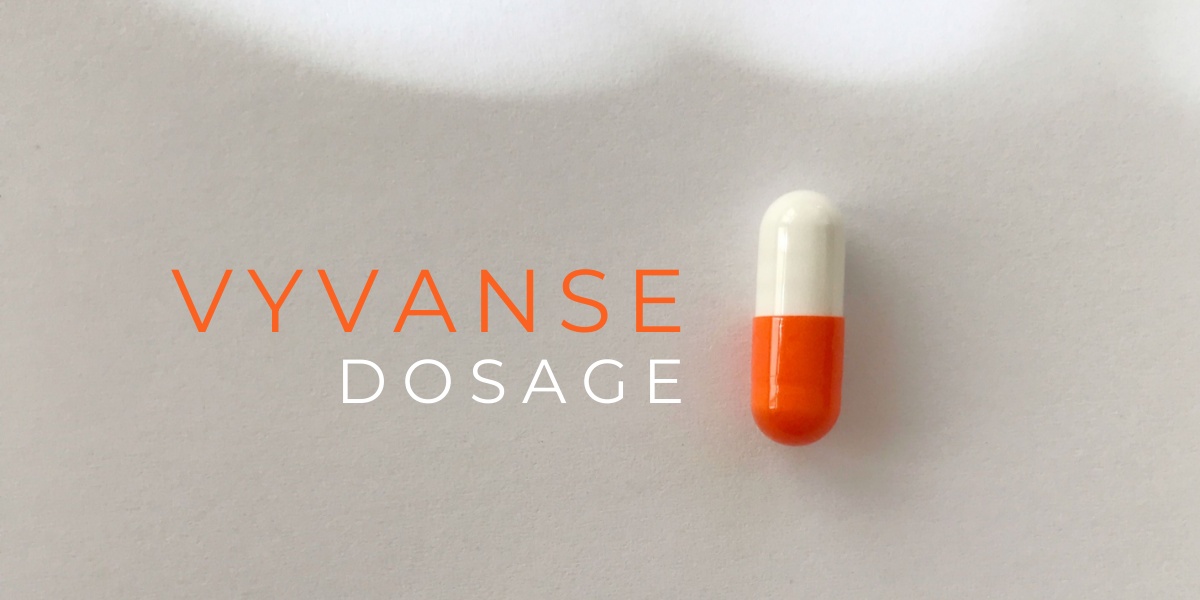Vyvanse is a stimulant medication containing lisdexamfetamine, which is used to treat ADHD and binge eating disorder. It can cause adverse effects, dependence, addiction, and/or overdose, so it should always be used exactly as prescribed and never misused. Treatments are available for people who have developed a dependence or addiction to Vyvanse.
- Vyvanse (lisdexamfetamine) is a central nervous system stimulant medication used to treat ADHD.
- Vyvanse can cause side effects, addiction and dependence, and risks to physical and mental health, particularly if misused.
- It is important to take Vyvanse exactly as it has been prescribed, as taking too much or too little can cause adverse effects or a worsening of symptoms.

Understanding Vyvanse dosage
Vyvanse (lisdexamfetamine dimesylate) is a medication that works as a central nervous system (CNS) stimulant. It is approved for use in the treatment of attention-deficit/hyperactivity disorder (ADHD) and moderate to severe binge eating disorder (BED) in adults. [1]
The daily dosage of Vyvanse will vary from person to person and can depend on the individual’s condition, age, weight, symptom severity, other health conditions, and response to the medication. Vyvanse capsules are available in strengths ranging from 10 mg to 70 mg, and chewable tablets in strengths from 10 mg to 60 mg.
Due to the potential for adverse effects, Vyvanse is commenced on a low dose and gradually increased. Typically, an initial dose is 30 mg a day, which is then increased by 10 or 20 mg increments each week as needed. [1][2] For people with ADHD, therapeutic doses can range from 30 mg to 70 mg. For BED, they range from 50 mg to 70 mg. [1] Vyvanse is taken as a single daily dose. It is often recommended to take this dose in the morning, as it can impact sleep if taken later in the day.
During treatment, the prescribing doctor will conduct regular reviews to monitor for adverse effects, check the effectiveness of the medication, and make adjustments as required.
Maximum dose of Vyvanse
Vyvanse can be taken by adults and children over the age of 6, up to a maximum daily dose of 70 mg. [1]
Certain factors might impact the safety of Vyvanse's maximum dosing. For example, people with severe renal impairment should have no more than 50 mg per day, and people with end-stage renal disease (ESRD) should take no more than 30 mg per day.
Vyvanse's side effects and risks
Vyvanse can cause side effects, particularly at the start of a new treatment or when increasing the dose. Typically, side effects will reduce after a couple of weeks. However, side effects that persist, worsen, or are problematic should be reported to a doctor, as it may be necessary to reduce the dosage or change medications.
Common side effects of Vyvanse include: [1][2][3]
- Reduced appetite
- Reduced weight
- Anxiety
- Diarrhea
- Dry mouth
- Dizziness
- Irritability
- Insomnia
- Nausea and vomiting
- Upper abdominal pain
- Increased heart rate
- Constipation
- Increased energy
- Restlessness
- Nightmares
Warnings and precautions
Warnings and precautions for people taking Vyvanse include: [1]
- Heart issues: Vyvanse can increase the risk of issues relating to blood pressure and heart rate, and there have been reported cases of sudden death, stroke, and heart attack, particularly in people with pre-existing heart conditions. As such, it may not be safe for people with known heart issues.
- Psychotic or manic symptoms: Vyvanse can cause or worsen psychotic or manic symptoms. As such, people with pre-existing mental health conditions should be evaluated and monitored closely.
- Growth suppression: The height and weight of children and young people taking Vyvanse should be monitored during treatment, as Vyvanse may suppress growth.
- Serotonin syndrome: Vyvanse can increase the risk of serotonin syndrome in large doses or when combined with other serotonergic medications.
- Pregnancy and breastfeeding: Vyvanse can cause harm to the fetus or breastfeeding infant. Use when pregnant or breastfeeding may not be advisable or may require close monitoring during treatment.
- Addiction: Vyvanse use can lead to the development of dependence and addiction. As such, it should always be taken only as prescribed, and individuals should be monitored for signs of addiction and abuse during treatment.
Dosage adjustment
A therapeutic dose of Vyvanse will vary depending on the individual. When commencing medication and during treatment, the prescribing doctor will monitor the individual and make dosage adjustments as necessary to find the safest effective dose.
Signs your Vyvanse dose may be too high
Someone taking a dose of Vyvanse that is too high might be more likely to experience: [1]
- Fast breathing and heart rate
- Agitation and restlessness
- Irritability or aggression
- Gastrointestinal issues
- Headaches
- Shaking
Signs your Vyvanse dose may be too low
If your Vyvanse dose is too low, it is likely that you will experience little or no change in your symptoms. For example, someone taking Vyvanse for ADHD might notice that they are continuing to experience difficulties paying attention or remaining focused on tasks and are easily distracted. This should be reported to the doctor, who can increase the dose.
Interactions
Vyvanse can interact with other substances and medications, potentially increasing the risk of adverse effects or reducing the therapeutic effects of the medication.
Vyvanse should not be used alongside monoamine oxidase inhibitors (MAOIs) as this can increase the risk of serotonin syndrome. Using Vyvanse alongside other antidepressants or serotonergic medications can also increase this risk. Concomitant use of antidepressants and Vyvanse may be clinically necessary, in which case, close monitoring is advised. [1][2]
Other products that can interact with Vyvanse include sodium bicarbonate and sodium phosphate. When taken with Vyvanse, they can decrease the excretion of the medication from the body, leading to increased blood levels and a longer duration of Vyvanse’s effects (including the risk of side effects). [1]
Always discuss prescribed and non-prescribed medications with the doctor before commencing a new medication.
Recognizing Vyvanse overdose
Taking large doses of Vyvanse can cause an overdose, which may lead to signs such as: [1][2]
- Uncontrollable
- Rapid breathing rate
- Confusion
- Hallucinations
- Panic
- Extreme changes in heart rate and blood pressure
- Nausea, vomiting, and diarrhea
- Seizures
- Loss of consciousness
In the event of a Vyvanse overdose, particularly if the person is struggling to breathe, has lost consciousness, or is experiencing convulsions, call 911 immediately.
Getting help for Vyvanse misuse
People misusing Vyvanse may require professional support to reduce and stop their use, particularly if they have developed a severe physical dependence or addiction to the medication. Professional support can include supported withdrawal, inpatient and outpatient treatment programs, therapies, and medications.
The Recovered Rehab Directory can be used to find out more about rehab centers offering Vyvanse misuse treatments.



-guide-detail.jpg?v=1743497813)